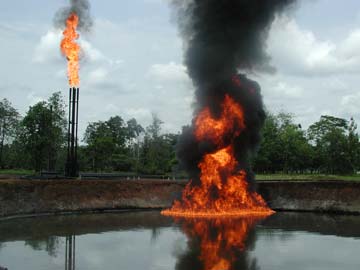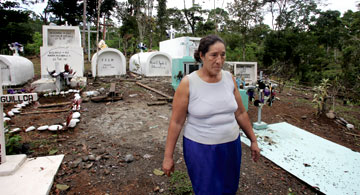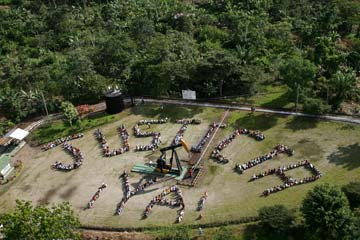
A Rainforest Chernobyl
In 1964, Texaco (now Chevron), discovered oil in the remote northern region of the Ecuadorian Amazon, known as the "Oriente."
The indigenous inhabitants of this pristine rainforest, including the Cofán, Siona, Secoya, Kichwa and Huaorani, lived traditional lifestyles largely untouched by modern civilization. The forests and rivers provided the physical and cultural subsistence base for their daily survival. They had little idea what to expect or how to prepare when oil workers moved into their backyard and founded the town of Lago Agrio, named for Texaco's birthplace of Sour Lake, Texas. The Ecuadorian government had similarly little idea what to expect; no one had ever successfully drilled for oil in the Amazon rainforest before. The government entrusted Texaco, a well-known U.S. company with more than a half-century's worth of experience, with employing modern oil practices and technology in the country's emerging oil patch. However, despite existing environmental laws, Texaco made deliberate, cost-cutting operational decisions that, for 28 years, resulted in an environmental catastrophe that experts have dubbed the "Rainforest Chernobyl."
Unlike the Exxon Valdez disaster that spilled over a billion gallons of crude during a one time cataclysmic event, Texaco's oil extraction system in Ecuador was designed, built, and operated on the cheap using substandard technology from the outset. This led to extreme, systematic pollution and exposure to toxins from multiple sources on a daily basis for almost three decades.

In a rainforest area roughly three times the size of Manhattan, Texaco carved out 350 oil wells, and upon leaving the country in 1992, left behind some 1,000 open toxic waste pits. Many of these pits leak into the water table or overflow in heavy rains, polluting rivers and streams that 30,000 people depend on for drinking, cooking, bathing and fishing. Texaco also dumped more than 18 billion gallons of toxic and highly saline "formation waters," a byproduct of the drilling process, into the rivers of the Oriente. At the height of Texaco's operations, the company was dumping an estimated 4 million gallons of formation waters per day,a practice outlawed in major US oil producing states like Louisiana, Texas, and California decades before the company began operations in Ecuador in 1967. By handling its toxic waste in Ecuador in ways that were illegal in its home country, Texaco saved an estimated $3 per barrel of oil produced.
Ongoing Devastation
Texaco's recklessness in the Oriente has caused a public health crisis. Studies have attributed at least 1401 excess cancer deaths in the region to oil contamination, as well as an elevated rate of pregnancies ending in miscarriage. The lives, land, and cultures of the region's native peoples were decimated, and today they find themselves struggling for survival. Texaco left Ecuador in 1992, turning over all its outdated oil operations and crumbling infrastructure to the country's state oil company, Petroecuador. Using the very same technology, Petroecuador continued to pollute, slowly modernizing its operations over time, but with a long way to go in improving its environmental record.

Meanwhile, Texaco conducted a sham "clean-up" of less than 1% of its former sites beginning in 1995, in most cases merely covering open pits with dirt or burning off the crude by-products. In cahoots with several corrupt government officials, Texaco obtained a "release" from liability based on its fraudulent remediation efforts. However, this release does not apply to individuals, who remained free to pursue legal action against Texaco. And by 1993, legal efforts to hold Texaco accountable had already begun.
Affected Communities Fight for Justice
Although they were caught off guard in 1964, the inhabitants of the Oriente have organized and are fighting back. Under the banner of the Frente de Defensa de la Amazonía (Amazon Defense Coalition), the Ecuadorian victims of Texaco's toxic mess have filed a landmark class-action lawsuit against the company. The lawsuit, first filed in 1993 in New York, continues today against Chevron in a Lago Agrio courtroom. Chevron inherited Texaco's toxic legacy when it bought the company in 2001. A milestone was reached in 2008, when a court-appointed independent expert recommended that Chevron be held liable for damages between $7 billion and $16.3 billion. That assessment of the damages was upped to $27 billion in November 2008, reflecting contamination, cancer deaths, and clean up costs previously unaccounted for.
The case is unprecedented. It marks the first time a U.S. company faces a judgment in a foreign court over environmental crimes, and experts are calling the damage the worst oil related contamination on the planet. A ruling against Chevron would have repercussions far beyond Ecuador. The oil industry and communities around the world are watching and waiting on the outcome. The verdict will either put multinational corporations on notice that they can and will be held accountable for environmental and human rights abuses anywhere in the world, or it will give them the green light to continue operating with business-as-usual impunity
